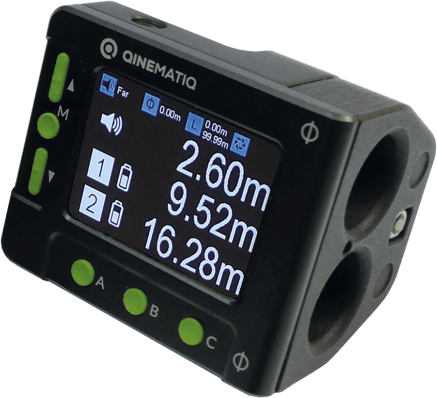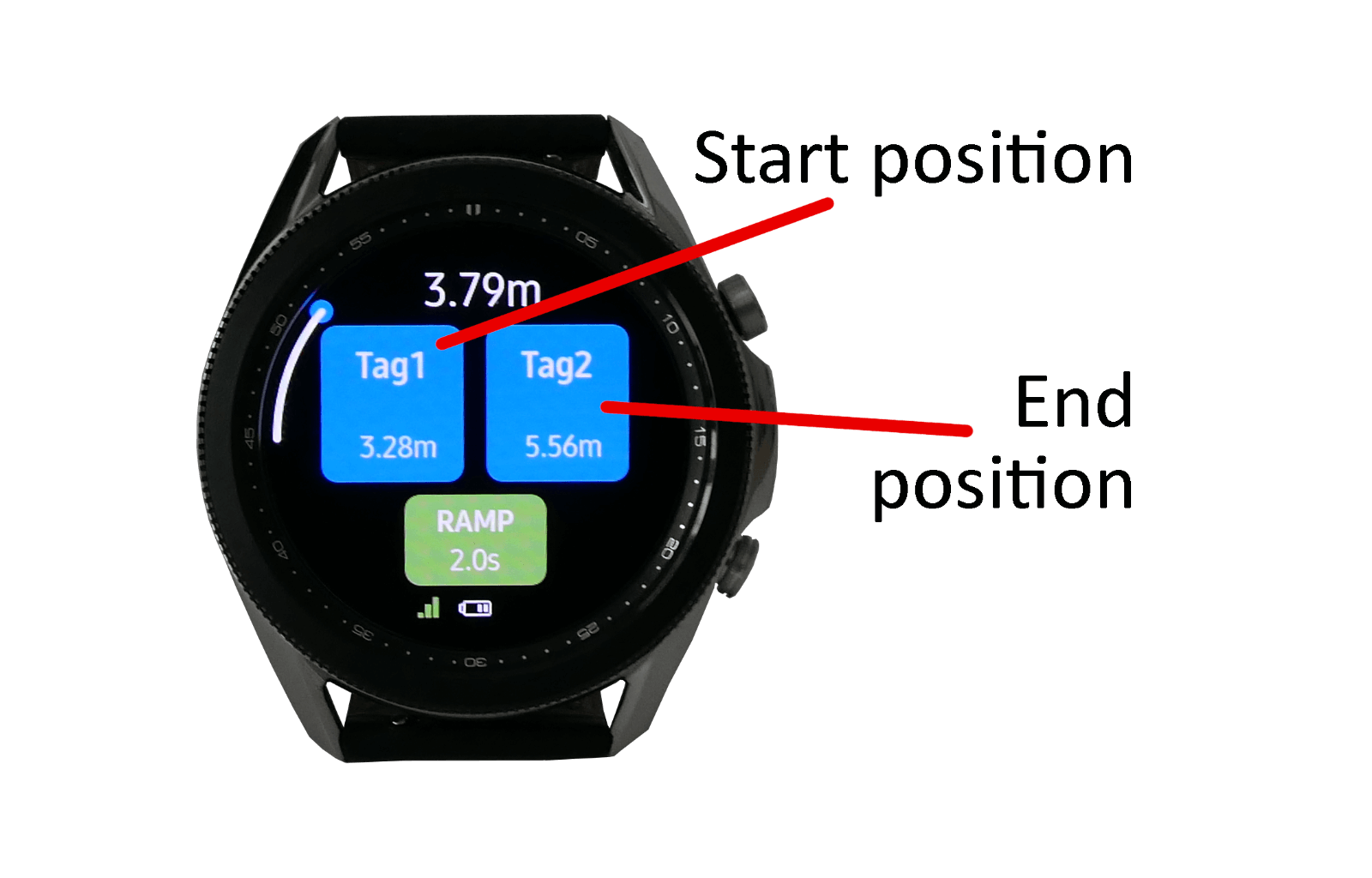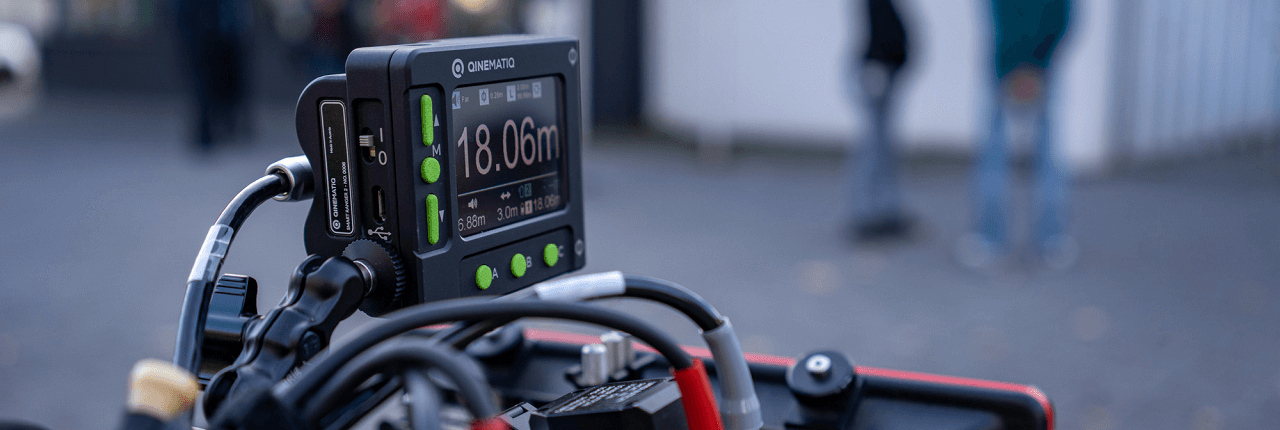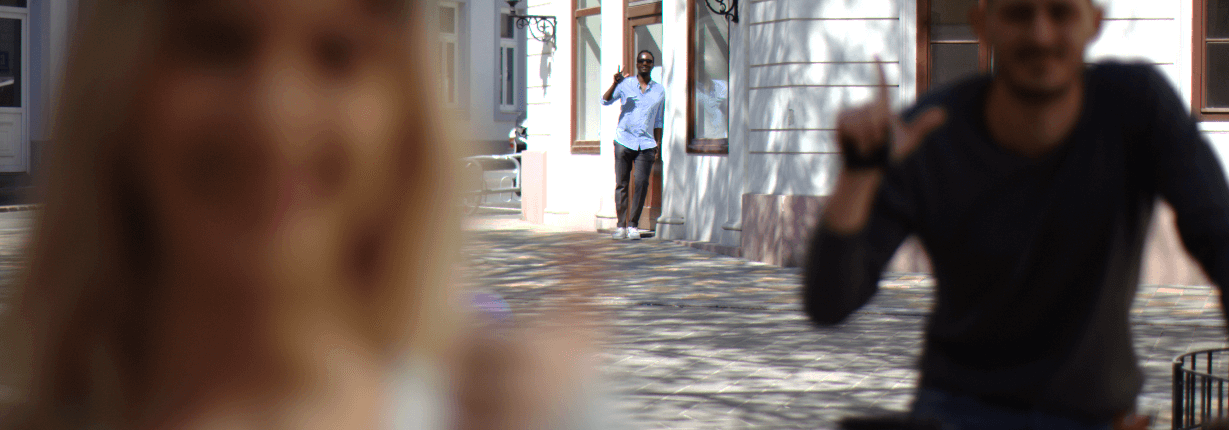Tag your distance
Two mobile radio tags can be fixed to subjects. The tag is tracked permanently. Distance measurement between subject and film plane is performed automatically.
Additionally the SMART RANGER 2 measures the distance to a subject in front of the film camera like a traditional ultrasonic measurement.

Range finding reinvented
While you concentrate on your subject in the foreground, two further objects are measured in the background.
That’s a big advantage.
A smart device in combination with a smartwatch
- Display distance measurements on the smartwatch
- Manual and automatic control of the focusing unit.
- Automatic focus switch between subject a and subject b.

Additional Advantages
- Measurement range from 20cm to over 80m (8 inches to over 250 feet)
- Autofocus ready
- Smart and compact design
- Patented technology
The Smart Ranger 2 has been awarded the Cine Gear Expo 2019 Technical Award – category “Camera Technology: Accessories”.
The Expo’s team of sixteen expert judges representing a variety of industry disciplines deliberated and voted on the worthy new technology candidates in 12 different product categories. In 2019 the Cine Gear Technical Achievement Awards drew 130 entries from 306 attending vendors.

A new patented measurement technology
SMART RANGER 2 is based on two different technologies: An ultrasonic sensor und a mobile radio tag. The advantage over previous measuring tools for a film set is obvious.
While the traditional ultrasonic sensor provides good measurement results for subjects up to a distance of 4m, at further distances the alignment with the subjects becomes difficult and reliable distance determination of actors over a distance of 6m is almost impossible.
In contrast the tag can easily capture subjects that are at a further distance to the camera, even when subjects are moving. And also glass panes, a hood of a car or clothes do not pose any problem for the tag. This applies even when the actor is walking around the corner: The subject is already measured before it comes into sight.
For measurements over 80m the tool can even replace a laser measurement system. Focusing on a person or a vehicle has been difficult and in case of moving objects even impossible. Now the tag provides the measurements, even if the subject is moving.
Tag your distance.

Autofocus ready
The SMART RANGER 2 is able to calculate the position of the focus motor from the measured distance. This makes an autofocus function possible. Additionally you can store lens tables in SMART RANGER 2. The device generates the distance data and control data for the focus motor.
The control data for the focus motor assists Lens Control Systems (LCS), which do not have their own autofocus functions or for direct control of ENG lenses with integrated motor control boxes.
If an external LCS allows an autofocus function, this can of course also be used. The focus motor automatically follows the distance.
In addition, the device allows continuous switching of the distance measurement between the ultrasonic sensor and the tag. The change is determined by the handover value, which is adjustable.
In addition, the SMART RANGER 2 allows an automatic switching between the ultrasonic sensor and the tag measurement. The changeover is determined by the handover value, which is adjustable. Please take a look at the practical example.
With this function, areas can be captured in the close up range, such as the face of an actor, where no tag can be placed. At the same time, moving subjects that are farther away can be tracked very easily.
This simplyfies complicated handling of focus adjustments for moving camera and subjects enormously.

A Smart tool with handy features
The big advantage of SMART RANGER 2 is the simultaneous measurement of 3 distances which can now be easily displayed on a smartwatch. This provides the user with a very practical overview of the positions of the subjects at all times.
In addition, the smartwatch allows a direct control of the focus of the camera. Any 2 measurements can be selected, for example the distance to tag 1 and the distance to tag 2. Between these two subjects an automated change of focus, a so-called focus ramp, can be performed. For example, tag 1 could be the start position of the ramp, tag 2 the end position.

At the push of a button the ramp is triggered and runs automatically from the start position to the end position. With a further push, it runs back. The ramp time can be determined freely. The actual position of the ramp is displayed on the screen of the smartwatch.

As a very interesting extension, the focus can also be shifted manually between the two subjects by turning the bezel of the smartwatch. This innovative feature works in combination with different lens control systems for cine-style lenses.

Rangefinding reinvented - use cases
The combination of two measurement technologies, two mobile tags, a soft switch between close-up and far range measurement, the autofocus function, the distance values on a smartwatch, an automatic focus ramp by pressing a button, delivers a wide range of novel assists for focusing a camera.
- Determining the distance of the actor’s eyes and simultaneously tracking another 2 subjects
- Working with one tag fixed on the clapperboard; switch the focus to the clapperboard
- Continuously determining the distance between the camera and an actor/actress moving towards the camera from long shots to close-up or moving away from close-up
- Measuring an actor moving around the corner of a building: Before the subject comes into view, the distance is already available, and the focus puller can focus on it.
- Steadicam or gimbal use: The actor wears the tag underneath their clothing. The camera follows the actor. The distance data is permanently available.
- A camera on a drone follows a fast driving motorcycle
- The camera is on a pick-up car or on car crane, the subject is another car.
- A camera on a cable pull moves towards a moving subject.
- Subjects on one ship are filmed from another ship.
- The camera is placed on a crane and moves through space, the distance to the subject is difficult to assess. SMART RANGER 2 is a helpful tool in all cases where distance measurement is difficult or distances change permanently.
- Simple setting of 2 marker points: The film camera is moved before shooting starts, reference markers are often changing and constant re-measuring is required. Thanks to SMART RANGER 2, all reference markers are updated accordingly.
- Measuring through glass panes or tree leaves
- And many more
… and all with or without autofocus mode.
Distance measurement has never been easier.
Rangefinding reinvented.
Range
Dual distance measurement tool with distance determination based on ultrasound and or radio tag.
Base unit and tag are connected via a highly robust radio connection. With SMART RANGER 2, measurements can be performed inside and outside of buildings. The tag can be attached to the human body. The transmission power of the system is many times smaller than those of a mobile phone, wireless lens control system or wireless video link.
SMART RANGER 2 works in parallel to those radio systems. They are not impacted or disturbed, and do in turn neither impact nor disturb the distance measurement.
Technical specification
Specifications and technical data are subject to change without notice.
Austrian patent. International patent pending.
Connecting and Expanding:
The base station of SMART RANGER 2 has a Lemo 6p serial interface that can be used for connecting a lens control system (LCS). This makes it possible to display the distance value on the LCS hand unit. This option is available for all lens control systems supporting the ultrasonic measurement systems cinetape or Arri UDM, for example lens control systems by Arri, cmotion, Preston or Chrosziel.
Additionally 2 Lemo 4p CAN bus interfaces are available for future use.
FAQ
How can ENG lenses be actuated?
SMART RANGER 2 can be attached from it's 6p lemo connector directly to the motor box of the ENG lens. If the matching lens table is available, the correct motor position data will be used to actuate the lens. The focus then automatically follows the measurement of the SMART RANGER 2.
How many lenses can be remembered in lens tables?
At the moment 32 lenses can be stored.
What is the handover threshold value?
It is the predefined threshold to determine the changeover between the close-up and far range measurement.
A handover threshold of 4 meters means that as soon as the subject enters a range of 4m the measurement switches from the tag to the ultrasonic sensor.
This means:
A measurement of 5 meters would come from the tag, placed in the pocket of the actor (even if out of view).
A measurement of 3 meters would come from the ultrasonic sensor as well as the eye tracking.
The switch is seamless.
What’s the difference between tag and ultrasonic sensor measurement?
The Tag sends out a microwave signal, with it's travel time being read by the SMART RANGER 2. The level of the signal is very low (much lower than smartphone signals) as to not interfer with other devices.
Once the tag is activated, the measurement is done automatically. The travel time measurement can be inaccurate and can be distorted by contuctive objects. eg: a tag placed under the hood of a car.
To increase accuracy a distance offset can be set to manage the effect of the distortion.
The ultrasonic sensor sends out a signal and receives its reflection of surfaces. The travel time is measured from the sender to the receiver. In this case not a specific point is measured but a smal circular area. This area is a big advantage in close-up, as neither nose nor the movement of the face have any sizable impact on the precision of the measurement. That is aso why ultrasonic sensor measurement has been the perferred technology in use on film sets for years.
The downside is that the size of the circular area of measurement increases with the distance. That has advers effects on locating the subject. At distances of 6 meters the ultrasonic sensor has to be targeted very precisely to still track the subject correctly.
Documents
Videos
Repairs
Before sending in a malfunctioning unit, please check first the FAQs section, send an email or call us for on-the-spot troubleshooting.
Any photos, videos, or detailed description of the circumstances surrounding the issue are extremely helpful in the evaluation and repair process.
If you’re unsure about what components to send in, please contact us so we can ensure we receive all necessary pieces to properly troubleshoot the issue.
For inhouse repair send all units to:
qinematiq Gmbh
Millergasse 21/5
1060 Vienna
Austria
Tel: +43 (1) 597 11 21
Mail: support@qinematiq.com
Please include a description of the issue(s).





